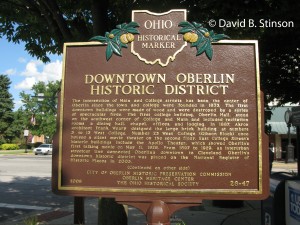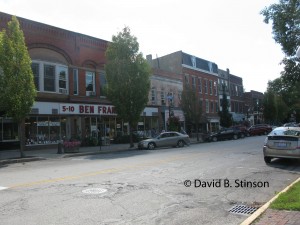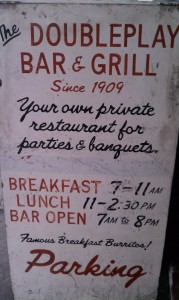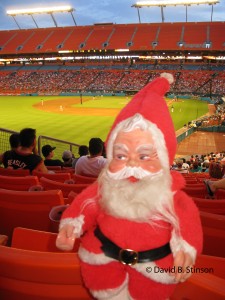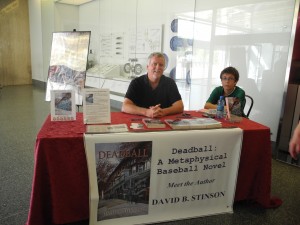Last month my publisher received an email from the campus bookstore at the University of Central Florida inquiring about ordering copies of my book Deadball, A Metaphysical Baseball Novel. Long story short, turns out Deadball is one of eight required readings for Baseball and American Culture (AMH3930h), an honors course being taught this semester at the University. The course explores: “The history of baseball and its interaction with a variety of areas of American culture from the 19th through the early 21st century.” The course is taught by Dr. Richard Crepeau, a distinguished Professor of History at UCF, Author, and Chair of the Department. An honor, indeed! I certainly hope the students enjoy the story of Byron Bennett.
Each year my family and I take our Chirstmas card photo at a major league ballpark. In celebration of the season, here are some photos of the prop we take with us on our trips – a vintage Coca Cola Santa doll – all taken where baseball no longer is played or the stadium no longer exits.
Merry Christmas and Happy Holidays! DBS
Looking for a baseball fix this off-season? Can’t get enough of the Baltimore Orioles? Read on.
While conducting research for my book Deadball, A Metaphysical Baseball Novel I became quite familiar with the lost ballpark sites of Baltimore, including Union Park, home of the 1890’s world champion National League Baltimore Orioles, and American League Park, home of the 1901-02 American League Baltimore Orioles and the 1903-1914 International League Orioles – including Babe Ruth (a previous ballpark known as Oriole Park once sat at the same location as American League Park and was where the American Association Baltimore Orioles played from 1890 until May 1891). Union Park and American League Park were located just four blocks apart, Union Park at the southwest corner of East 25th Street and Guilford Avenue, and American League Park at the southwest corner of East 29th Street and Greenmount Avenue.
In addition to Union Park and American League Park, two other ballparks were once located nearby. Terrapin Park (also known as Oriole Park), home of the 1914-15 Federal League Terrapins, the International League Orioles, and the 1938-1944 Negro American League Baltimore Elite Giants, was located directly across the street from American League Park at the northwest corner of East 29th Street and Greenmount. Memorial Stadium (and its earlier incarnation known as Municipal Stadium) home of the International League Orioles (1944-1953) and the “new” American League Orioles (1954-1991) was located .7 miles north and east of American League Park on 33rd Street.
Over the past few years, I occasionally have given tours of the old ballpark sites to die-hard Orioles fans and history buffs. This fall, I continued that tradition. In October, Bruce Brown, a friend and fellow SABR member toured the sites of Union Park, American League Park, and Terrapin Park.
And most recently, this past November, I made the same trek to Baltimore with friend and fellow author Austin Gisriel (Safe at Home, A Season in the Valley). Austin and I also toured the former site of Memorial Stadium, which Austin chronicled on the SABR blog Seamheads (see Seamheads.com).

Author Austin Gisriel at the Former Site of Union Park. The Building in the Background Once Sat Just To the Right of Union Park's Third Base Side Grandstand (see above picture of Union Park)
If you are interested in a tour of these sites, let me know. Just send me a comment to this posting (you may need to click on the title to this post – “Touring The Lost Ballparks of Baltimore” and scroll to the bottom of the page for the reply option) or send me a note on my facebook page – David B. Stinson. If there is enough interest, I’ll arrange a tour. With winter soon upon us, a tour of Baltimore’s lost ballpark sites could provide that much needed off-season baseball fix. In the meantime, below are four entries from my companion blog deadballbaseball.com with pictures and information about these lost ballpark sites. Enjoy!
Go O’s!
 A few years back – 15 to be exact – I had the pleasure of collaborating with singer songwriter Julie Sanderson on an original Christmas song – Christmas 1864. She wrote the music and I wrote the lyrics,. The song was released on one of Jeff Campbell’s wonderful Hungry For Music Holiday Feast CD’s (Volume 2). It has since been re-released on A Holiday Feast, Creme de la Creme. Julie Sanderson sang and played guitar on the song. Accompanying her were Pete and Maura Kennedy. Pete also produced the song and recorded it in his studio. His masterful instrumental accompaniment gave the song a distinctly Civil War feel.
A few years back – 15 to be exact – I had the pleasure of collaborating with singer songwriter Julie Sanderson on an original Christmas song – Christmas 1864. She wrote the music and I wrote the lyrics,. The song was released on one of Jeff Campbell’s wonderful Hungry For Music Holiday Feast CD’s (Volume 2). It has since been re-released on A Holiday Feast, Creme de la Creme. Julie Sanderson sang and played guitar on the song. Accompanying her were Pete and Maura Kennedy. Pete also produced the song and recorded it in his studio. His masterful instrumental accompaniment gave the song a distinctly Civil War feel.
Just before Thanksgiving this year, my brother Jim and I put the song to video, using public domain Matthew Brady images of the Civil War, most taken in and around Petersburg, Virginia, which is where the song’s story took place. Here’s the video: Christmas 1864 Youtube Video. Go ahead, give it a click.
For those of you looking for a little holiday mood music, what better way to rekindle the excitement of Christmas than listening to a song lamenting the stark reality of Christmas during wartime. For those of you looking for a place to round out your end-of-the-year gift giving, Hungry For Music is a non profit organization dedicated to providing musical instruments to young people who otherwise cannot afford them. Here is a link to that fine organization: Hungry For Music.

If you are attending the Baltimore Book Festival, please look for me in the author’s tent on Friday September 28th. I will be there from noon – 8 pm selling and signing copies of Deadball. Here is a link with the info: Baltimore Book Festival






